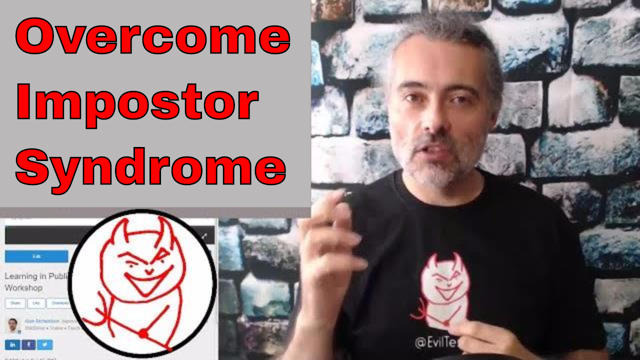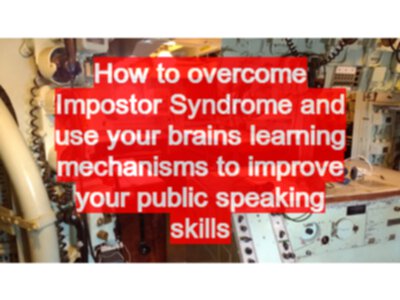TLDR; I presented a workshop at the Sigist on 14th September 2017 on Public Speaking. Unpack what “Imposter Syndrome” means to you, to identify actionable steps to improve your public speaking. You can rewire your brain by revisiting ’normal’ experiences of speaking in public as public speaking.

I presented a workshop at the Sigist on 14th September 2017 on Public Speaking. I found it very useful to hear different experiences of public speaking and the kind of things that people find difficult and the kind of things that people find easy.
On Workshops
The great thing about a workshop is that it can go in different directions than you, the host, things that it might.
For any workshop:
- I create enough material that if there is no engagement then I have enough content to cover the time
- I build in flexibility to respond to what the participants state their needs as
- I use the material as a base to keep the workshop going
If we don’t get through all the slides in a workshop that is fine, we add value through the discussions.
You can find the slides online
How to improve your public speaking
Take advantage of opportunities that come your way.
I wanted to evaluate how I speak in public, so when the opportunity to host a workshop came my way, I jumped on the opportunity.
During the conference, one of the speakers didn’t attend, so I took the opportunity to fill in and present a 25 minute version of a 45 minute Keynote that I will be presenting next week. This gave me the chance to learn in public a little more about the talk I’m planning.
I gain, by presenting, and I try and add as much value in my content to the audience as I can. Win Win.
Impostor Syndrome
One thing that cropped up in the discussions in the workshop was the notion of Impostor Syndrome.
Which people often describe in many ways:
- I don’t feel experienced enough to discuss the topic
- My ideas might not be good enough
- People might react the wrong way
- Other people can present this better
And all of that justification is fine, it help maintain the illusion of a ’thing’ called “Impostor Syndrome”. Which is a label given to a fairly ordinary and common set of experiences.
But…
As soon as we have a label, we can agree to identify with the label rather than explore the process that the label is abstracting.
‘Labeling’ is described well in Chris Voss’s book “Never Split The Difference” where Chris Voss describes his experiences as an FBI Hostage Negotiator and applies his learning to sales and negotiation processes.
One technique described was ‘Labeling’ where the negotiator describes the experience of the other person, as the negotiator perceives it:
“It looks like you don’t want to come out. It seems like you worry that if you open the door, we’ll come in with guns blazing”
The negotiator didn’t say “You don’t want to come out”:
- which is ambiguously also a command
- the other party might have to correct by defending their situation
- might be taken as an identity assessment “you are someone who does not want to come out”
This provides a common base of understanding, which the other party can correct without having to defend. And if they do so then the negotiator labels the new information.
But as a label it means we don’t have to deal with all the baggage or reasons which led up to the current situation.
In The Structure of Magic Bandler and Grinder look at the language patterns in therapy and describe techniques that therapists use to unpack the abstractions, ambiguities and labels that clients use to describe their problems. By unpacking them the therapist can identify behaviour changes or suggestions to offer the client.
As a ‘reversal’ of this, in “Patterns of the Hypnotic Techniques of Milton H. Erickson” Bandler and Grinder explore the use of ambiguity as a way of communicating with multiple levels of meaning and to use the labeling style of communication described by Chris Voss to create a base of understanding which may not actually have a shared experience but is accepted as a shared understanding for both parties.
If we want to improve:
- unpack the labels that we use to describe experience
- address the behaviours and processes that are described
Use your brain’s learning mechanisms to help
I think that ‘fear of public speaking’ is a learned response, and often we have generalised a bunch of disparate experiences into a label of “I can’t speak in public”.
Since our brain very effectively weaves together lots of experiences to draw this conclusion we can help it generalise in a different way.
Think of all the successful experiences you have had with public speaking:
- when you answered your phone as you were walking down the street
- when you spoke to your friends in a bar or restaurant
- when you spoke to your team in a team meeting
- when you spoke to your family at a family gathering
If you mentally label these as ‘Public Speaking’ then your brain will start to collate them and then you can create a different base experience for your brain to build labels from.
That might help you take opportunities for public speaking when they arise.
Bonus YouTube Video
I expand on these points in the following YouTube video:
And you can find the slides online







